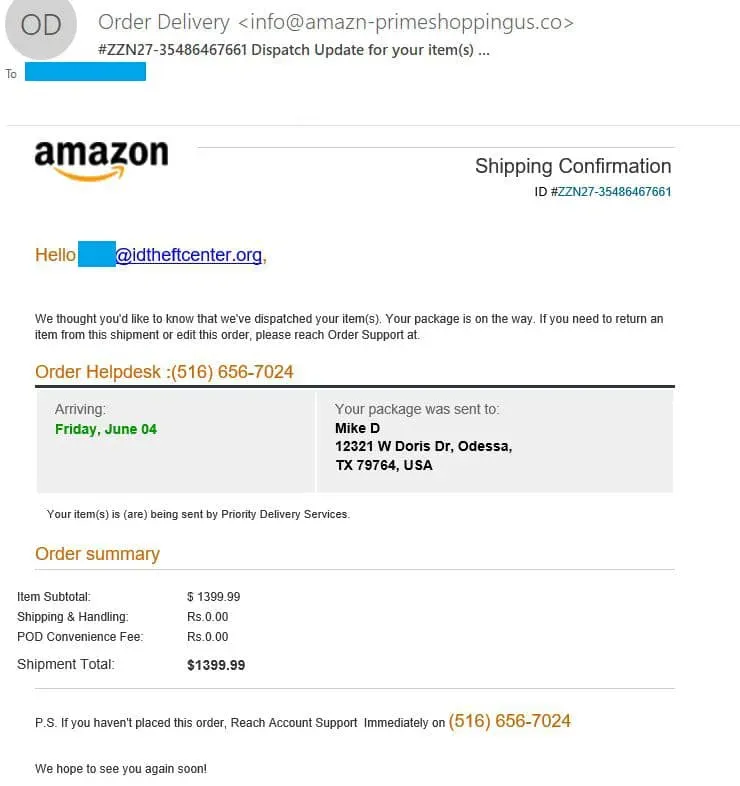As Amazon Prime Day approaches, the allure of unbeatable deals draws in millions of eager shoppers, but it also attracts a wave of criminals ready to exploit the excitement. This rise in Amazon Prime Day scams is alarming, with security experts uncovering over 120,000 fraudulent websites designed to deceive unsuspecting buyers. These counterfeit platforms, rife with phishing traps and malware, threaten online shopping security as they mimic genuine Amazon offerings. To ensure a safe shopping experience, it’s essential to know how to avoid Amazon scams and recognize the telltale signs of a fraudulent website. By arming yourself with Prime Day shopping tips and being aware of Amazon phishing sites, you can confidently navigate the deals this July—without falling prey to deceitful tactics.
With the surge in online retailing during major sales events, the risk of facing scams has never been higher. Retailers like Amazon, especially during their popular Prime Day, become hotspots for deceptive practices aimed at duping consumers. The rapid increase in fraudulent online platforms trying to capitalize on shoppers’ rush raises crucial questions about internet safety and protection. To safeguard your purchases and ensure a satisfying shopping experience, it’s vital to recognize the signs of scams and thoroughly understand safe buying practices. Following key online shopping security guidelines can help you remain vigilant and enjoy the thrill of shopping without the worry of being scammed.
Understanding the Rise of Amazon Prime Day Scams
The excitement surrounding Amazon Prime Day creates a prime opportunity for scammers to target unsuspecting shoppers. With promotional sales drawing millions of customers online, phony sites can capture sensitive information rapidly. Researchers have identified a staggering number of over 120,000 counterfeit Amazon websites, all designed to deceive avid consumers looking for the best deals. These scams tend to surge as the Prime Day event approaches, which not only highlights their opportunistic nature but also underscores the necessity for shoppers to stay alert during this high-stakes shopping period.
To protect themselves, shoppers are encouraged to become more discerning in their online shopping habits. Cybercriminals rely on the frantic rush of consumers wanting to purchase items at discounted prices, which can lead to hasty decisions. Recognizing why these scams proliferate during Peak shopping events like Prime Day is crucial for consumer safety; vigilance is key to mitigate the risks associated with online shopping.
Essential Prime Day Shopping Tips to Stay Safe Online
As the race for bargains heats up, adopting a few essential Prime Day shopping tips can greatly increase your chances of avoiding scams. Start by shopping exclusively through direct links from Amazon.com or its official app, ensuring that you are not inadvertently navigating to a fraudulent site. Additionally, steer clear of sharing any personal information over the phone, as Amazon representatives will never solicit such details in that manner. By adhering to these practices, you can fortify your defenses against potential scams.
Furthermore, exercising caution when it comes to payment methods is imperative. Be wary if a seller requests payment through unconventional channels such as gift cards, as this could be a red flag of fraud. It’s also vital to double-check URLs before proceeding with any transactions and report any suspicious activity directly to Amazon’s support page. Using secure payment methods and verified seller ratings goes a long way in ensuring that your Prime Day experience is safe and enjoyable.
Recognizing Amazon Phishing Sites Before It’s Too Late
Phishing sites can be deceptively similar to legitimate Amazon pages, making it essential for shoppers to be able to recognize them before sharing any sensitive information. These fraudulent sites can entice users with offers that seem too good to be true, luring them into a trap where they might unknowingly provide account details or financial data. Learning to identify certain red flags—such as poor website design, misspellings, or incorrect URLs—can significantly protect consumers from falling victim to online scams, particularly during busy shopping periods like Prime Day.
Moreover, it is beneficial for shoppers to arm themselves with knowledge about common phishing tactics employed by scammers. Many phishing emails or messages may appear authentic, often featuring Amazon branding to create a misplaced sense of security. By familiarizing yourself with the common signs of phishing attempts, such as unpersonalized greetings or unusual sender addresses, you can navigate the shopping landscape more confidently and keep yourself secure during the Amazon Prime Day sales.
The Importance of Online Shopping Security
In today’s digital marketplace, online shopping security is more important than ever. With the surge in online transactions, shoppers must adopt best practices to protect themselves from identity theft and financial loss. This includes using strong and unique passwords for their accounts and enabling two-factor authentication on any platforms utilized for purchases. Additionally, regular monitoring of bank statements and credit reports can help ensure that unauthorized charges are detected swiftly.
Investing in a robust security system for your devices can further enhance your safety while shopping online. Keeping your operating system and applications updated ensures that you have the latest security patches to keep cyber threats at bay. By understanding the importance of online shopping security, consumers can shop more confidently, especially during high-traffic sales events like Amazon Prime Day.
How to Identify Real Deals versus Scams on Prime Day
During Prime Day, it’s crucial to distinguish between legitimate deals and scams. Shoppers should familiarize themselves with the usual price range for items they intend to purchase to recognize when a discount may be exaggerated or misleading. Researching sellers and reading reviews can provide valuable insights into whether a deal is genuine or just a ploy to entice buyers into buying counterfeit or non-existent products.
Additionally, leveraging tools and platforms that track price history can be a wise strategy to ensure that the discounts presented are indeed substantial. Consumers who stay informed about market trends and price fluctuations will be in a better position to discern whether a deal is worth pursuing or if it’s just a ruse. By keeping an eye on these aspects, shoppers can optimize their Prime Day experience and make smart purchases.
Preparing Your Accounts for Prime Day Shopping
Before delving into Prime Day shopping, it’s vital to prepare your accounts properly. Start by ensuring that your Amazon account is secured with a strong, unique password. Coupling it with two-factor authentication is a powerful defense against unauthorized access. Cybercriminals often leverage compromised accounts to conduct fraudulent transactions, so taking preventative measures is essential.
Additionally, review any payment methods saved to your account. Ensure that they are up-to-date, and consider removing any old methods that you no longer use. This minimizes the risk of unauthorized purchases and maintains better control over your finances during busy shopping events. Establishing a secure foundation can greatly enhance your shopping experience on Prime Day.
The Role of Technology in Combating Prime Day Scams
In an era where technology evolves rapidly, it plays a pivotal role in combating online fraud, especially during events like Amazon Prime Day. Advancements in machine learning and artificial intelligence allow security systems to detect fraudulent patterns and activities in real-time, providing a safer shopping environment for consumers. Companies like Amazon invest heavily in these technologies to protect their customers from scams and other cyber threats.
Moreover, technology also arms consumers with tools to protect themselves against potential pitfalls. Browser extensions and apps that flag unsafe websites can serve as an additional layer of security during online shopping. As technology continues to grow, so do the methods employed by scammers; hence, consumers must rely on technological tools to stay one step ahead in identifying and avoiding scams.
The Impact of Consumer Awareness on Prime Day Fraud Prevention
Consumer awareness is a powerful ally in fighting against scams, particularly during high-profile shopping events like Amazon Prime Day. Educated consumers are less susceptible to fraud; they possess the knowledge needed to identify potential threats and recognize the signs of fake offers. This heightened awareness not only protects individual shoppers but also helps to combat the proliferation of scams.
Organizations and online retailers can further empower consumers by sharing resources and information on recognizing fraudulent schemes. By promoting proactive online shopping security measures among their customer base, companies can create a more informed environment that reduces the likelihood of scams succeeding. Collaborative efforts to raise awareness are crucial in building a safer online shopping community.
Reporting Scams: How Consumers Can Take Action
When consumers encounter scams, it is vital to take action and report the incidents. Reporting fraudulent activities not only helps protect the individual but also contributes to broader efforts to combat scams. Amazon provides consumers with specific resources to report suspicious sellers and counterfeit products. By utilizing these channels, shoppers can play an active role in maintaining the integrity of the marketplace.
Furthermore, sharing experiences on social media or consumer forums can inform others of prevalent scams and increase overall vigilance. A connected community where experiences and information are shared bolsters the collective defense against scams targeting unsuspecting shoppers. Through proactive reporting and community engagement, consumers can help diminish the impact of scams associated with events like Amazon Prime Day.
Frequently Asked Questions
How can I avoid Amazon Prime Day scams when shopping online?
To avoid Amazon Prime Day scams, always shop through official Amazon channels, such as Amazon.com or the official app. Be cautious of websites that closely mimic Amazon’s domain and never share account information over the phone. Make sure to use strong, unique passwords and enable two-factor authentication for added security.
What should I watch for to protect myself from Amazon phishing sites during Prime Day?
To protect yourself from Amazon phishing sites during Prime Day, always double-check website URLs for authenticity, as scammers often create similar-looking domains. Look for signs of security at the checkout process, such as HTTPS in the URL, and be wary of unsolicited emails or messages requesting personal information or payments.
What are some Prime Day shopping tips to ensure a safe buying experience on Amazon?
Some Prime Day shopping tips include shopping only through Amazon’s official website or app, avoiding public Wi-Fi when making purchases, and being skeptical of deals that seem too good to be true. Always verify seller ratings and reviews to ensure you’re buying from legitimate sources.
How can I report suspicious activity related to Amazon Prime Day scams?
If you encounter suspicious activity during Amazon Prime Day shopping, report it immediately through Amazon’s support page. Providing details about the scam can help Amazon combat these threats more effectively.
Why are scammers targeting consumers with Amazon scams around Prime Day?
Scammers target consumers with Amazon scams around Prime Day due to the high volume of online shoppers eager to score deals. The urgency can lead to hasty decisions, making it easier for cybercriminals to exploit shoppers.
What measures does Amazon take to fight against scams, especially during Prime Day?
Amazon actively combats scams by taking down phishing websites, like the over 55,000 removed in 2024, and monitoring for impersonation schemes. They also provide guidelines and tools to help shoppers recognize and avoid potential scams.
What types of scams should I be aware of while shopping during Amazon Prime Day?
While shopping during Amazon Prime Day, be aware of phishing scams, fake websites, and offers that sound too good to be true. Scammers may also try to solicit gift card payments or personal information, which legitimate Amazon representatives will never ask for.
Why is online shopping security critical during Amazon Prime Day sales?
Online shopping security is critical during Amazon Prime Day sales because the event attracts a surge of shoppers, making it prime opportunity for scammers. Protecting personal and financial information ensures a safer shopping experience while still enjoying great deals.
| Aspect | Details |
|---|---|
| Overview | Over 120,000 fake Amazon sites identified targeting shoppers ahead of Prime Day. |
| Timing | The scams are emerging just before Prime Day sales (July 8-11). |
| Scam Methods | Phishing traps, malware, and fake products are being used on these scam sites. |
| Amazon’s Efforts | In 2024, Amazon removed over 55,000 phishing websites and 12,000 impersonation phone numbers. |
| Consumer Vigilance | Shoppers must remain vigilant as threats evolve. |
| Protection Tips | Top 10 tips include shopping only on official Amazon channels and using strong passwords. |
Summary
Amazon Prime Day scams are on the rise, as cybercriminals exploit the excitement of shoppers seeking great deals. With over 120,000 fake Amazon sites detected, it is crucial for consumers to be aware and protect themselves. Using official channels, staying alert for phishing attempts, and adhering to best online shopping practices will help safeguard against these scams. Following these precautions is essential to ensure a safe shopping experience during one of the biggest sales events of the year.



